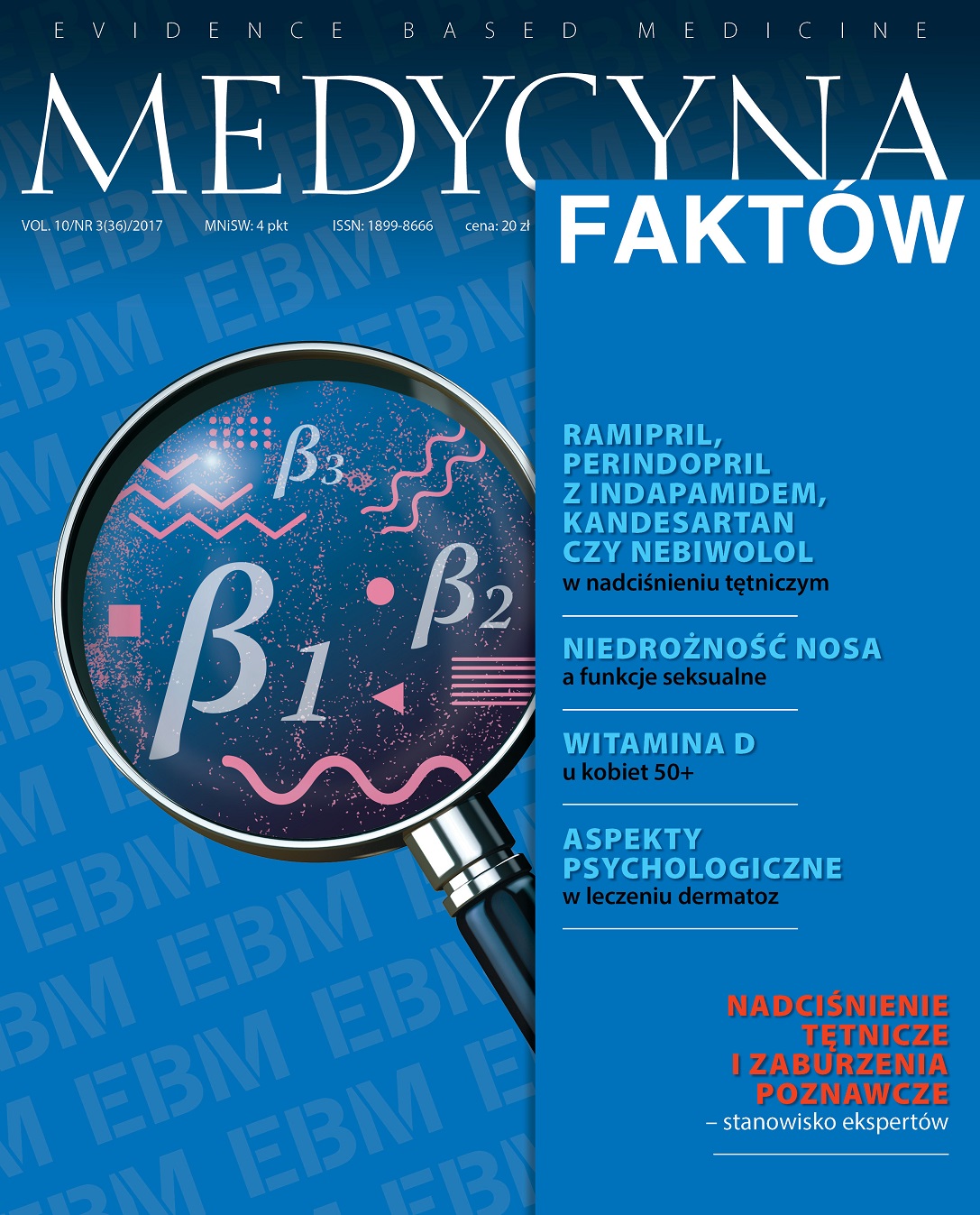Candesartan – the strongest AT1 receptor blocker Review article
Main Article Content
Abstract
The renin–angiotensin–aldosterone system plays an important role in pathogenesis of many cardiovascular diseases, i.e. hypertension, heart failure. Sartans block angiotensin II type 1 receptor and they are frequently used in clinical practice. Many studies have shown that there are no class effect in sartans. Each sartan differs significantly from another. In this paper we present clinical characteristics which differs candesartan from other angiotensin II type 1 receptor blockers.
Article Details
How to Cite
Grabowski , M., & Januszkiewicz , Łukasz. (2017). Candesartan – the strongest AT1 receptor blocker. Medycyna Faktow (J EBM), 10(3(36), 201-204. Retrieved from https://journalsmededu.pl/index.php/jebm/article/view/2123
Issue
Section
Articles
Copyright © by Medical Education. All rights reserved.
References
1. Aulakh G.H., Sodhi R.K., Singh M.: An update on non-peptide angiotensin receptor antagonists and related RAAS modulators. Life Sciences 2007; 81: 615-639.
2. Joint National Committee. Sixth National Report of the Joint National Committee on Prevention, Detection, Evaluation and Treatment of High Blood Pressure (JNC VI). Arch. Intern. Med. 1997; 157: 2413-2446.
3. McMurray J.J., Ostergren J., Swedberg K. et al.: Effects of candesartan in patients with chronic heart failure and reduced left-ventricular systolic function taking angiotensin-converting-enzyme inhibitors: the CHARM-Added trial. Lancet 2003; 362: 767-771.
4. Granger C.B., McMurray J.J., Yusuf S. et al.: Effects of candesartan in patients with chronic heart failure and reduced left-ventricular systolic function intolerant to angiotensin-converting-enzyme inhibitors: the CHARM-Alternative trial. Lancet 2003; 362: 772-776.
5. Yusuf S., Pfeffer M.A., Swedberg K. et al.: Effects of candesartan in patients with chronic heart failure and preserved left-ventricular ejection fraction: the CHARM-Preserved Trial. Lancet 2003; 362: 777-781.
6. Papademetriou V., Farsang C., Elmfeldt D. et al.: Stroke prevention with the angiotensin II type 1-receptor blocker candesartan in elderly patients with isolated systolic hypertension: the Study on Cognition and Prognosis in the Elderly (SCOPE). J. Am. Coll. Cardiol. 2004; 44: 1175-1180.
7. Schrader J., Lüders S, Kulschewski A. et al.: The ACCESS Study. Evaluation of Acute Candesartan Cilexetil Therapy in Stroke Survivors. Stroke 2003; 34: 1699-1703.
8. Hansson L.: The relationship between dose and anti-hypertensive effect for different AT1-receptor blockers. Blood Press. 2001;10(supl. 3): 33-39.
9. Bakris G., Gradman A., Reif M. et al.: Antihypertensive efficacy of candesartan in comparison to losartan: the CLAIM study. J. Clin. Hypertens. 2001; 3: 16-21.
10. Lacourcière Y., Asmar R.: A comparison of the efficacy and duration of action of candesartan cilexetil and losartan as assessed by clinic and ambulatory blood pressure after a missed dose, in truly hypertensive patients. A placebo-controlled, forced titration study. Am. J. Hypertens. 1999; 12: 1181-1187.
11. Himmelmann A., Keinanen-Kiukaanniemi S., Wester A. et al.: The effect duration of candesartan cilexetil once daily, in comparison with enalapril once daily, in patients w ith mild to moderate hypertension. Blood Press. 2001; 10: 43-51.
12. Julius S., Nesbitt S.D., Egan B.M. et al.: Feasibility of treating prehypertension with an angiotensin-receptor blocker. N. Engl. J. Med. 2006; 354: 1685-1697.
2. Joint National Committee. Sixth National Report of the Joint National Committee on Prevention, Detection, Evaluation and Treatment of High Blood Pressure (JNC VI). Arch. Intern. Med. 1997; 157: 2413-2446.
3. McMurray J.J., Ostergren J., Swedberg K. et al.: Effects of candesartan in patients with chronic heart failure and reduced left-ventricular systolic function taking angiotensin-converting-enzyme inhibitors: the CHARM-Added trial. Lancet 2003; 362: 767-771.
4. Granger C.B., McMurray J.J., Yusuf S. et al.: Effects of candesartan in patients with chronic heart failure and reduced left-ventricular systolic function intolerant to angiotensin-converting-enzyme inhibitors: the CHARM-Alternative trial. Lancet 2003; 362: 772-776.
5. Yusuf S., Pfeffer M.A., Swedberg K. et al.: Effects of candesartan in patients with chronic heart failure and preserved left-ventricular ejection fraction: the CHARM-Preserved Trial. Lancet 2003; 362: 777-781.
6. Papademetriou V., Farsang C., Elmfeldt D. et al.: Stroke prevention with the angiotensin II type 1-receptor blocker candesartan in elderly patients with isolated systolic hypertension: the Study on Cognition and Prognosis in the Elderly (SCOPE). J. Am. Coll. Cardiol. 2004; 44: 1175-1180.
7. Schrader J., Lüders S, Kulschewski A. et al.: The ACCESS Study. Evaluation of Acute Candesartan Cilexetil Therapy in Stroke Survivors. Stroke 2003; 34: 1699-1703.
8. Hansson L.: The relationship between dose and anti-hypertensive effect for different AT1-receptor blockers. Blood Press. 2001;10(supl. 3): 33-39.
9. Bakris G., Gradman A., Reif M. et al.: Antihypertensive efficacy of candesartan in comparison to losartan: the CLAIM study. J. Clin. Hypertens. 2001; 3: 16-21.
10. Lacourcière Y., Asmar R.: A comparison of the efficacy and duration of action of candesartan cilexetil and losartan as assessed by clinic and ambulatory blood pressure after a missed dose, in truly hypertensive patients. A placebo-controlled, forced titration study. Am. J. Hypertens. 1999; 12: 1181-1187.
11. Himmelmann A., Keinanen-Kiukaanniemi S., Wester A. et al.: The effect duration of candesartan cilexetil once daily, in comparison with enalapril once daily, in patients w ith mild to moderate hypertension. Blood Press. 2001; 10: 43-51.
12. Julius S., Nesbitt S.D., Egan B.M. et al.: Feasibility of treating prehypertension with an angiotensin-receptor blocker. N. Engl. J. Med. 2006; 354: 1685-1697.

